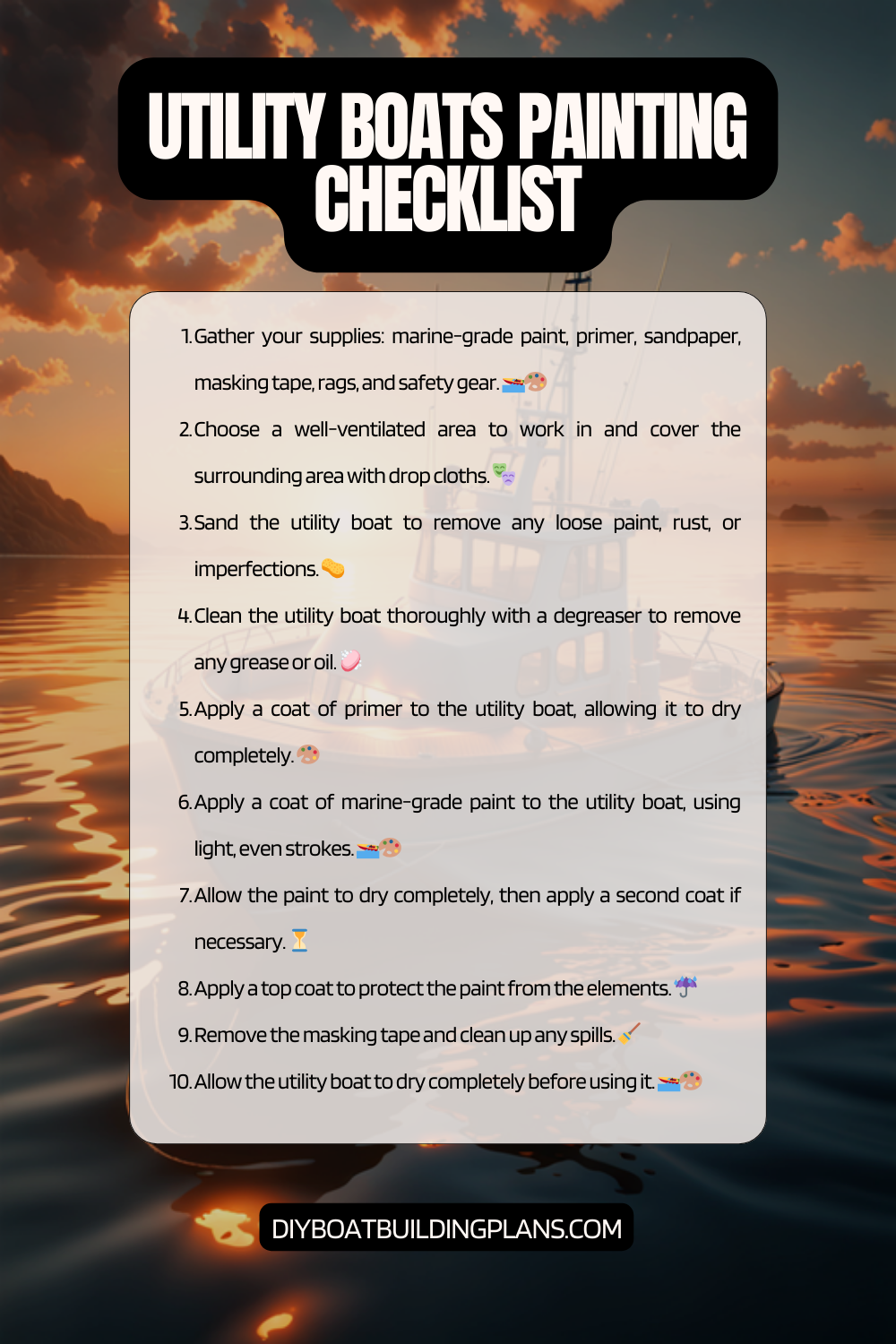Overview of Utility Boats Painting Tips
Utility boats painting refers to the process of applying paint to the exterior surfaces of boats used for various purposes such as fishing, transportation, and recreational activities. It is an essential aspect of boat maintenance and plays a crucial role in protecting the boat from corrosion, enhancing its appearance, and increasing its lifespan. While utility boats are designed to withstand harsh conditions, regular painting is necessary to ensure their longevity and optimal performance.
Key Takeaways
- Painting utility boats is important for both aesthetic and functional reasons.
- Choosing the right paint and properly preparing the surface are crucial for a successful paint job.
- Applying primer and using proper painting techniques can help achieve a smooth finish.
- Regular maintenance is necessary to keep the painted surface looking good and protecting the boat.
- Safety precautions should always be taken when painting utility boats.

Importance of Painting Utility Boats
One of the primary reasons for painting utility boats is to protect them against corrosion and rust. When exposed to water, salt, and other environmental elements, the metal surfaces of the boat can deteriorate over time. By applying a protective layer of paint, you create a barrier that prevents moisture from reaching the metal, thus reducing the risk of corrosion and rust formation.
In addition to protection, painting utility boats also enhances their appearance. A well-painted boat not only looks visually appealing but also gives a sense of pride to its owner. Whether you use your boat for personal or commercial purposes, a fresh coat of paint can make a significant difference in its overall aesthetic appeal.
Furthermore, painting utility boats increases their lifespan. By providing a protective layer, paint helps to prevent damage caused by UV rays, water exposure, and general wear and tear. This extends the life of the boat and reduces the need for costly repairs or replacements in the future.
Choosing the Right Paint for Utility Boats
When it comes to choosing paint for utility boats, it is important to select a type that is specifically designed for marine applications. Marine paints are formulated to withstand constant exposure to water, sunlight, and harsh weather conditions. There are two main types of marine paints suitable for utility boats: antifouling paint and topside paint.
Antifouling paint is specifically designed to prevent the growth of marine organisms such as barnacles and algae on the boat’s hull. It contains biocides that deter the attachment of these organisms, thus reducing drag and improving fuel efficiency. Topside paint, on the other hand, is used for the above-water areas of the boat and is available in various finishes such as gloss, semi-gloss, and matte.
When choosing paint for utility boats, consider factors such as durability, ease of application, and compatibility with the boat’s material. It is also advisable to opt for reputable brands that have a proven track record in the marine industry. Some recommended brands for utility boat painting include Interlux, Pettit, and Awlgrip.
Preparing the Surface for Painting
| Surface Preparation Metrics | Measurement |
| Surface Cleanliness | Visual Inspection |
| Surface Roughness | Surface Profile Gauge |
| Surface Moisture Content | Moisture Meter |
| Surface Temperature | Infrared Thermometer |
| Surface Porosity | Porosity Tester |
Before applying paint to a utility boat, it is crucial to properly prepare the surface to ensure optimal adhesion and a smooth finish. The first step in surface preparation is cleaning the boat thoroughly. Remove any dirt, grease, or contaminants using a mild detergent or boat cleaner. Pay special attention to areas prone to buildup such as the waterline and transom.
Once the boat is clean, sanding the surface is necessary to create a rough texture that allows the paint to adhere better. Use sandpaper with a grit suitable for your boat’s material and work in a consistent motion, following the grain of the surface. This step helps remove any existing paint or varnish and provides a clean canvas for the new paint.
After sanding, inspect the boat for any cracks or holes that need to be filled. Use an appropriate marine-grade filler to repair these imperfections. Once the filler has dried, sand it down until it is smooth and level with the surrounding surface.
Finally, before painting, it is essential to apply a degreaser to remove any remaining oils or contaminants from the surface. This step ensures that the paint adheres properly and prevents any potential issues with peeling or bubbling.
Tips for Applying Primer on Utility Boats
Priming is a crucial step in the utility boat painting process as it provides a smooth and even base for the topcoat. Primer helps to seal the surface, improve adhesion, and enhance the durability of the paint job. It also acts as a barrier between the boat’s material and the paint, preventing any potential reactions or damage.
When choosing a primer for utility boats, opt for a marine-grade product that is compatible with the type of paint you will be using. Epoxy primers are commonly used for their excellent adhesion and corrosion resistance. However, consult the manufacturer’s recommendations to ensure compatibility with your specific boat and paint system.
When applying primer, follow the manufacturer’s instructions regarding mixing ratios, application techniques, and drying times. It is important to apply thin, even coats to avoid excessive buildup or drips. Use a high-quality brush or roller suitable for the type of primer being used, ensuring smooth and consistent coverage.
Techniques for Painting Utility Boats
Choosing the right brush or roller is essential for achieving a professional-looking paint job on utility boats. For smaller areas or intricate details, use a high-quality brush with synthetic bristles that are designed for marine applications. Brushes with tapered edges allow for precise control and smooth application.
For larger areas, such as the hull or deck, a roller is more efficient and provides a smoother finish. Use a roller cover specifically designed for marine paints to ensure proper application and minimize texture or stippling.
When applying paint to utility boats, it is important to work in thin layers rather than applying one thick coat. Thin coats dry faster and allow for better adhesion between layers. Additionally, painting in thin layers reduces the risk of runs, drips, or sagging.
Choosing the right weather conditions is also crucial when painting utility boats. Avoid painting in extreme temperatures or high humidity as these conditions can affect the drying time and overall quality of the paint job. Ideally, choose a day with mild temperatures, low humidity, and minimal wind to ensure optimal conditions for painting.
Tips for Achieving a Smooth Finish on Utility Boats
To achieve a smooth finish on utility boats, it is important to sand between coats. This step helps to remove any imperfections, such as dust particles or brush marks, and creates a smooth surface for the next coat of paint. Use a fine-grit sandpaper and sand in a gentle, circular motion. Wipe away any dust with a clean cloth before applying the next coat.
Applying a topcoat is another important step in achieving a smooth and durable finish. Topcoats provide additional protection against UV rays, chemicals, and general wear and tear. Choose a marine-grade topcoat that is compatible with the primer and paint system you have used. Apply thin, even coats using the appropriate brush or roller, following the manufacturer’s instructions.
After the final coat of paint has dried, consider buffing the boat surface to further enhance its appearance and smoothness. Buffing removes any minor imperfections or swirl marks, leaving behind a glossy and polished finish. Use a buffing compound specifically designed for boat surfaces and follow the manufacturer’s instructions for best results.
Maintenance Tips for Painted Utility Boats
To ensure the longevity of your painted utility boat, regular maintenance is essential. Regularly clean the boat using a mild detergent or boat cleaner to remove dirt, salt residue, and other contaminants. Avoid using abrasive cleaners or brushes that can damage the paint.
Touching up any scratches or chips promptly is also important to prevent further damage or corrosion. Keep some extra paint on hand for touch-ups and follow the manufacturer’s instructions for proper application.
Proper storage of your utility boat is crucial to protect the paint job when not in use. Store the boat in a covered area away from direct sunlight and extreme weather conditions. If storing outdoors, consider using a boat cover to provide additional protection.
Download over 500 Boat Plans. Click on the link below.
-->Click Here<--
Common Mistakes to Avoid When Painting Utility Boats
One common mistake when painting utility boats is rushing the process. Taking the time to properly prepare the surface, apply primer, and paint in thin layers is crucial for a long-lasting and professional-looking finish. Rushing can lead to poor adhesion, uneven coverage, and premature paint failure.
Another mistake to avoid is not preparing the surface properly. Skipping steps such as cleaning, sanding, and filling cracks can result in poor paint adhesion and an uneven finish. Proper surface preparation is essential for a successful paint job.
Using the wrong type of paint is another common mistake when painting utility boats. Using interior or exterior house paint, for example, will not provide the necessary protection or durability required for marine applications. Always choose marine-grade paints that are specifically formulated for boat surfaces.
Safety Precautions When Painting Utility Boats
When painting utility boats, it is important to prioritize safety. Wear appropriate protective gear such as gloves, safety glasses, and a respirator to protect yourself from paint fumes and chemicals. Ensure proper ventilation in the workspace by opening windows or using fans to remove fumes.
Handle paint and chemicals safely by following the manufacturer’s instructions regarding storage, usage, and disposal. Avoid contact with skin or eyes and wash hands thoroughly after handling paints or chemicals.
Utility Boats Painting Checklist

Conclusion – Utility Boats Painting Tips
In conclusion, painting utility boats is a crucial aspect of boat maintenance that offers numerous benefits. It protects against corrosion and rust, enhances the appearance of the boat, and increases its lifespan. When painting utility boats, it is important to choose the right paint, properly prepare the surface, apply primer, and use proper techniques for achieving a smooth finish.
Regular maintenance, including cleaning and touch-ups, is necessary to ensure the longevity of the paint job. By avoiding common mistakes and following safety precautions, you can achieve a professional-looking paint job that will keep your utility boat looking great for years to come. Take the time to properly paint and maintain your utility boat, and you will be rewarded with a vessel that not only performs well but also turns heads on the water.
FAQs – Utility Boats Painting Tips
What are utility boats?
Utility boats are small to medium-sized boats that are designed for various purposes such as transportation, fishing, and recreation. They are typically made of aluminum or fiberglass and are powered by outboard motors.
Why is painting important for utility boats?
Painting is important for utility boats because it helps protect the boat from the elements, such as saltwater, UV rays, and corrosion. It also helps improve the appearance of the boat and can increase its resale value.
What type of paint should I use for my utility boat?
The type of paint you should use for your utility boat depends on the material of the boat and the type of paint job you want. For aluminum boats, you should use a marine-grade paint that is specifically designed for aluminum. For fiberglass boats, you can use either a one-part or two-part marine-grade paint.
How do I prepare my utility boat for painting?
To prepare your utility boat for painting, you should first clean the boat thoroughly with soap and water. Then, you should sand the boat to remove any old paint or rough spots. After sanding, you should clean the boat again to remove any dust or debris. Finally, you should apply a primer to the boat to help the paint adhere better.
What are some tips for painting my utility boat?
Some tips for painting your utility boat include using a high-quality paintbrush or roller, applying thin coats of paint, and allowing each coat to dry completely before applying the next coat. You should also paint in a well-ventilated area and wear protective clothing, such as gloves and a mask.



